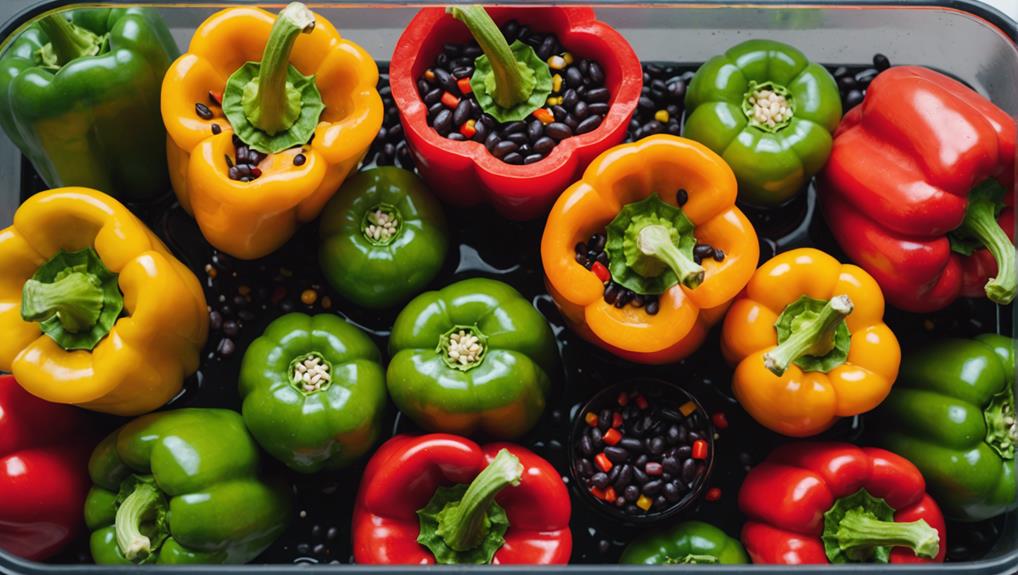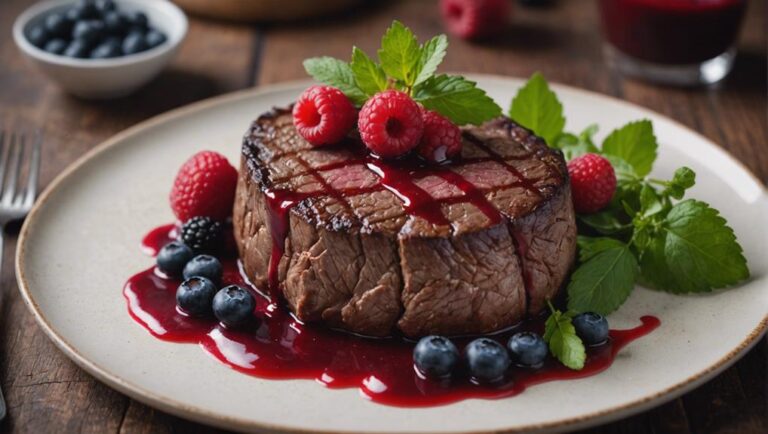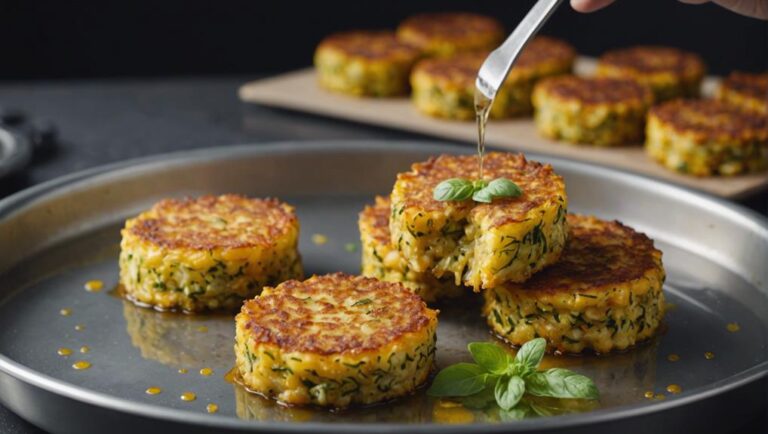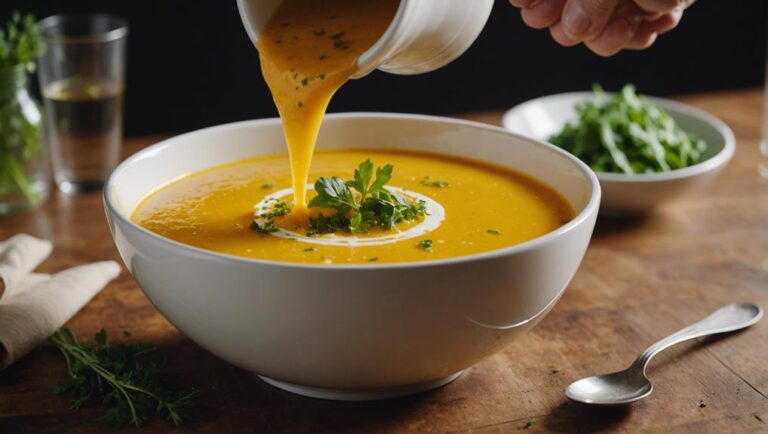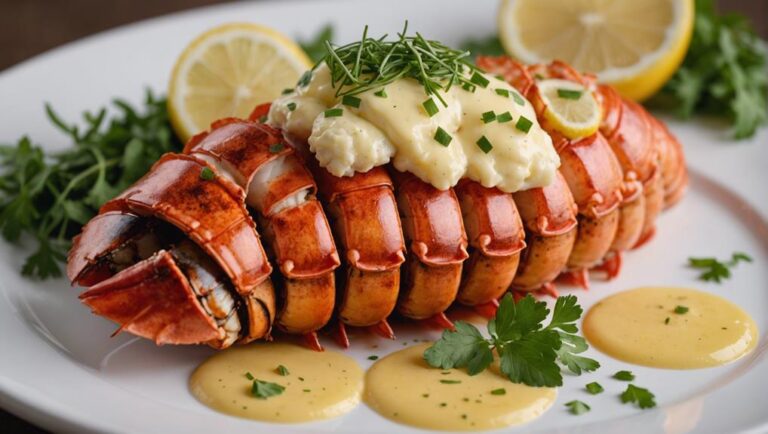Sous Vide Vegetarian Stuffed Peppers
To create delicious Sous Vide Vegetarian Stuffed Peppers, fill bell peppers with quinoa, black beans, and your choice of flavorful ingredients. Seal in airtight bags and cook in a water bath for tender perfection. The precise temperatures of sous vide enhance flavors and textures, resulting in a truly elevated dish. By embracing this cooking method, you'll discover a world of culinary possibilities and tantalizing tastes. Mastering this technique guarantees your peppers are cooked evenly and bursting with flavor. Explore the depths of vegetarian cuisine with this delightful dish.
What You Will Learn Here
- Sous vide method ensures precise cooking temperatures for perfectly cooked vegetarian stuffed peppers.
- Flavor infusion is enhanced with sous vide, ensuring even distribution of tastes throughout the dish.
- Vegetables retain maximum nutrients and flavors in sous vide cooking for a wholesome vegetarian meal.
- Sous vide technique locks in moisture, resulting in juicy and flavorful vegetarian stuffed peppers.
- Sous vide elevates the culinary experience by providing consistent and delectable vegetarian stuffed peppers.
Stuffed Pepper Origins
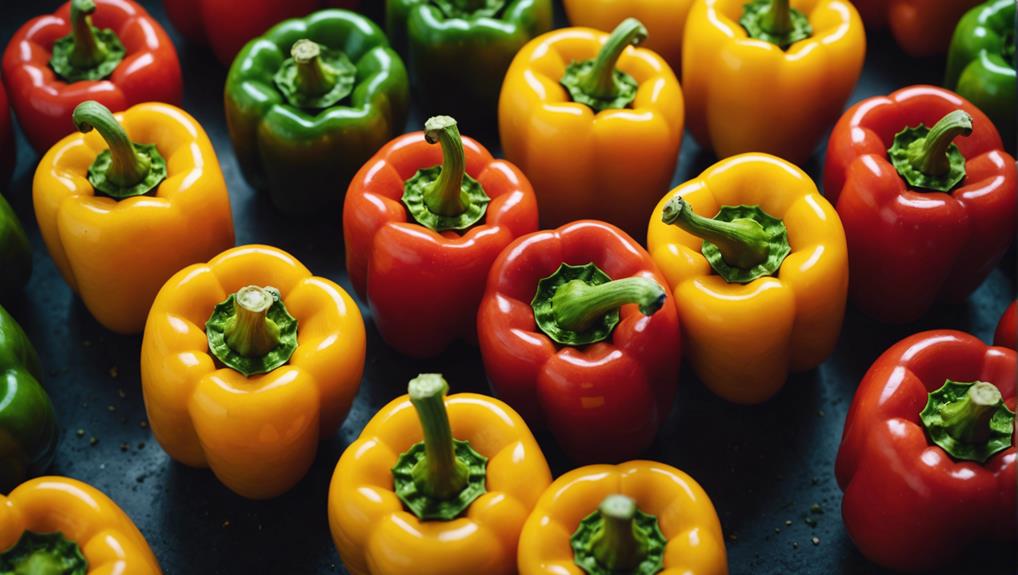
When considering the origins of stuffed peppers, it's essential to explore the historical evolution, traditional methods of pepper stuffing, and the modern adaptations of this dish. Understanding the historical context provides insight into the cultural significance and culinary practices associated with stuffed peppers.
Traditional pepper stuffing techniques vary across regions and cultures, influencing the ingredients and flavors used in the dish.
Historical Stuffed Pepper
Having originated in the Mediterranean region, the historical stuffed pepper dish has evolved over centuries into various culinary interpretations around the world.
The pepper stuffing typically consists of a mixture of ingredients such as rice, herbs, spices, and sometimes meat or other vegetables. Stuffed pepper evolution has seen adaptations in different cultures, leading to variations in the type of peppers used, the filling ingredients, and cooking methods.
This evolution reflects the diverse culinary traditions and preferences of regions where the dish has become popular. From the Middle East to Europe and the Americas, stuffed peppers have been embraced and transformed, showcasing the versatility of this dish.
The historical journey of stuffed peppers highlights the ability of a simple concept to adapt and thrive in diverse culinary landscapes.
Traditional Pepper Stuffing
The traditional pepper stuffing used in stuffed peppers serves as the foundational element that defines the origins and essence of this classic dish. When exploring the history of stuffed peppers, it becomes clear that the stuffing itself is an essential component that has evolved over time to accommodate various culinary preferences and dietary choices.
Flavorful variations have emerged, catering to different tastes and dietary restrictions, with some opting for a vegetarian twist by incorporating ingredients such as lentils, quinoa, or tofu. Cooking techniques play a significant role in enhancing the flavor profiles of the stuffing, whether it involves sautéing the ingredients to build depth or slow-cooking them to meld flavors together.
Understanding the traditional pepper stuffing is essential in appreciating the rich culinary heritage behind stuffed peppers.
Modern Stuffed Pepper
Exploring the evolution of stuffed peppers reveals the intricate origins and adaptations that have shaped the modern variations of this classic dish.
Over time, stuffed peppers have transformed to embrace a multitude of flavor profiles and textures through the use of flavorful seasonings and innovative presentation techniques.
Creative filling combinations, such as quinoa and black bean or couscous and chickpea, have become popular choices to cater to diverse palates.
The modern stuffed pepper not only focuses on taste but also on aesthetics, with chefs experimenting with unique textures like crunchy breadcrumbs or creamy cheeses to elevate the dining experience.
Staple Ingredients
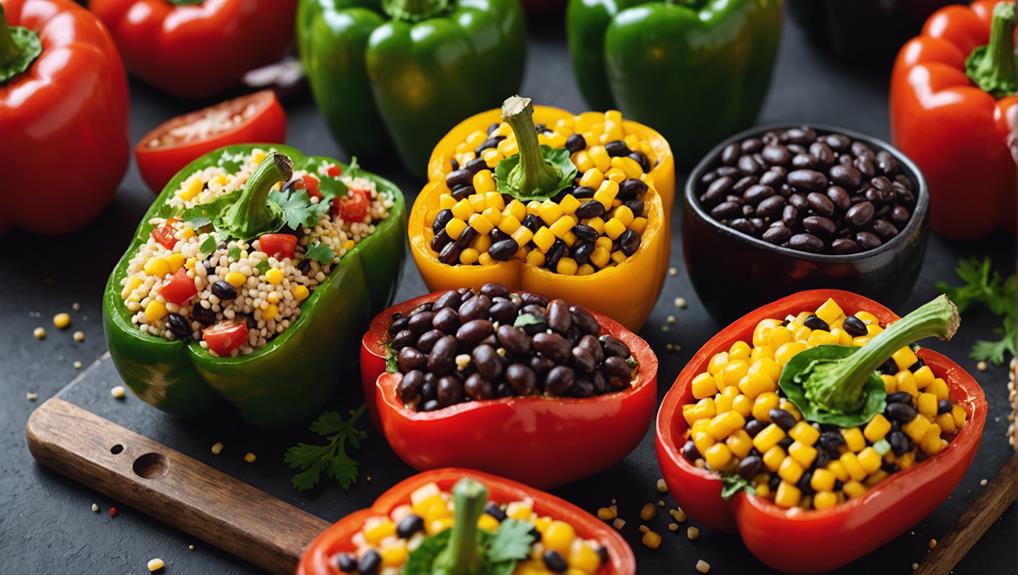
For this recipe, gather the essential staple ingredients that will form the base of your Sous Vide Vegetarian Stuffed Peppers. Make sure you have the following items ready:
- Bell Peppers: Choose fresh, firm bell peppers in various colors for an eye-catching presentation. These will serve as the edible vessel for your delicious stuffing.
- Quinoa: This protein-packed grain will be the nutritious filling for your stuffed peppers. Quinoa is a great vegan option that complements the other ingredients perfectly.
- Black Beans: Adding black beans to your filling not only enhances the flavor but also provides a good source of plant-based protein. Make sure they're cooked and ready to be mixed in with the quinoa.
With these staple ingredients on hand, you're all set to create a flavorful and satisfying dish that's sure to impress. Stay tuned for the next steps in preparing your Sous Vide Vegetarian Stuffed Peppers.
Top Stuffed Pepper Variations
Explore the culinary landscape with variations like the Savory Quinoa-Stuffed Pepper, a protein-packed option that adds depth to the dish.
Consider the Lentil-Stuffed Pepper for a hearty alternative that brings a rich, earthy flavor profile.
The Mushroom and Rice-Stuffed Pepper offers a satisfying blend of textures and umami notes that elevate the classic stuffed pepper experience.
Savory Quinoa-Stuffed Pepper
Consider enhancing the flavor profile by incorporating a medley of herbs and spices into the quinoa stuffing for a delectable Savory Quinoa-Stuffed Pepper variation. To achieve the best outcome, follow these key steps:
- Quinoa Preparation: Rinse the quinoa thoroughly before cooking to remove its natural coating, called saponin, for a cleaner taste.
- Flavor Infusion: Toast the quinoa in a dry skillet before cooking to enhance its nutty flavor and aroma.
- Pepper Texture: For a tender yet slightly crunchy texture, bake the stuffed peppers until the quinoa is cooked but still has a pleasant bite.
Lentil-Stuffed Pepper Option
To elevate the flavor profile of your stuffed peppers, venture into the domain of the Lentil-Stuffed Pepper option, introducing a heartier and protein-rich alternative to your culinary repertoire.
When considering the Lentil-Stuffed Pepper option, pay attention to the following:
- Lentil Texture: Lentils offer a satisfyingly chewy texture that contrasts beautifully with the softness of the pepper.
- Flavor Profile: The earthy and nutty flavor of lentils enhances the overall taste of the dish, creating a robust and wholesome experience.
- Protein-Rich: Lentils are a fantastic plant-based source of protein, making the Lentil-Stuffed Pepper a nutritious and filling meal option.
Embrace the versatility of lentils in your cooking and savor the delightful combination they bring to your stuffed peppers.
Mushroom and Rice-Stuffed Pepper
For a savory twist on traditional stuffed peppers, the Mushroom and Rice-Stuffed Pepper offers a delectable combination of earthy mushrooms and hearty rice nestled within a vibrant pepper shell. This vegetarian alternative provides a burst of flavors that will satisfy your taste buds.
Here are key points to ponder:
- Flavorful Filling: The mixture of sautéed mushrooms, cooked rice, aromatic herbs, and seasonings creates a rich and satisfying filling that complements the sweetness of the pepper.
- Vegetarian Alternative: Perfect for those looking for a meatless option that doesn't compromise on taste or texture.
- Customizable Options: Feel free to experiment with different types of mushrooms, rice varieties, or additional ingredients to cater to your preferences.
Enjoy a hearty and delicious meal with these Mushroom and Rice-Stuffed Peppers.
Stuffed Pepper Baking Techniques
When baking stuffed peppers, it's important to regulate oven temperature to guarantee even cooking.
Adjusting baking time based on pepper size and filling density is vital for achieving the desired texture.
Pay attention to ingredient moisture levels to prevent a dry or soggy final result.
Oven Temperature Control
Consider adjusting the oven temperature settings based on the desired texture of the stuffed peppers to achieve the best baking results. Temperature importance and control play a pivotal role in ensuring baking consistency and ideal outcomes.
By setting the oven temperature accurately, you can control how quickly or slowly the stuffed peppers cook, affecting their final texture. If you prefer a softer pepper, a lower temperature for a longer duration may be ideal. In contrast, a higher temperature will result in a firmer pepper.
Experimenting with different temperature settings will allow you to find the perfect balance to achieve the desired results. Remember, precise oven temperature control is key to mastering the art of baking stuffed peppers.
Baking Time Adjustments
To optimize the baking process for stuffed peppers, adjust the cooking time based on the desired level of doneness. Temperature adjustments play an important role in achieving the perfect texture for your stuffed peppers.
If you prefer a softer pepper, bake them at a lower temperature for a longer time to guarantee even cooking without burning the edges. On the other hand, if you enjoy a slightly firmer pepper, a higher temperature for a shorter duration may be more suitable.
Cooking tips suggest covering the peppers with foil for the first half of the baking time to retain moisture and prevent excessive browning. This method also aids in flavor infusion, allowing the ingredients to meld together for a delicious final result.
Ingredient selection plays a significant role in determining the overall taste and texture of the dish, so choose wisely.
Ingredient Moisture Retention
Maintain ideal moisture levels in your stuffed peppers by selecting ingredients known for their moisture retention properties, such as bell peppers, tomatoes, and cooked grains. Proper ingredient preparation is important to guarantee ideal moisture levels in your stuffed peppers.
When preparing your ingredients, consider the water content of each component to achieve a well-balanced filling. Additionally, cooking methods play a significant role in moisture retention. When using baking techniques, heat distribution within the oven can impact the final moisture levels of your dish.
Be mindful of the temperature and duration to prevent excessive evaporation of moisture from the ingredients. By carefully considering ingredient moisture levels and cooking methods, you can create perfectly moist and flavorful stuffed peppers.
Final Thoughts
In reflection, the overall process of preparing Sous Vide Vegetarian Stuffed Peppers highlights the importance of attention to detail in achieving best results. When utilizing sous vide cooking techniques, advantages such as flavor infusion are maximized through precise temperature control. The sous vide method allows for an even distribution of flavors, ensuring that each bite of the stuffed peppers is bursting with the intended taste profile.
To optimize your sous vide experience, remember to adhere to essential cooking tips. Maintaining temperature precision is vital in sous vide cooking to guarantee that the peppers are cooked to perfection. By carefully monitoring the water bath temperature, you can make sure that the peppers are cooked evenly without the risk of overcooking or undercooking.
Ultimately, the sous vide approach offers a level of control that traditional cooking methods may struggle to achieve. By embracing this meticulous cooking technique, you can elevate the flavors of your vegetarian stuffed peppers to new heights, providing a culinary experience that delights the senses.
Frequently Asked Questions
Can I Use a Different Type of Pepper for Stuffing?
Yes, you can use different pepper varieties for stuffing. Experimenting with various peppers like poblano, Anaheim, or sweet bell peppers can lead to exciting flavor variations in your dish, enhancing the overall culinary experience.
How Can I Adjust the Spice Level in the Filling?
To adjust the spice level in the filling to suit your taste preferences, you can control the amount of spicy ingredients used. Increase or decrease chili powder, hot sauce, or jalapenos for a balanced flavor profile.
Can I Make These Stuffed Peppers Ahead of Time?
You can definitely make the stuffed peppers ahead of time for meal prep ease. Store them in an airtight container in the fridge for up to 2 days. When ready to enjoy, simply reheat and savor!
What Are Some Creative Serving Suggestions for Stuffed Peppers?
For creative presentation ideas, try serving stuffed peppers on a bed of quinoa or alongside a revitalizing cucumber salad. Experiment with flavor combinations like Mexican-inspired peppers with avocado crema or Italian-style peppers with creamy pesto sauce.
Can I Freeze Leftover Stuffed Peppers for Later?
You can freeze leftover stuffed peppers for later by following these tips: seal them airtight, label with date, and use within 2-3 months for best taste. Reheat in the oven or microwave for a quick meal.
Conclusion
To sum up, sous vide vegetarian stuffed peppers offer a modern twist on a classic dish. By using precise temperature control and sealed bags, the ingredients are cooked evenly and retain their flavors.
Experimenting with different fillings and spices allows for endless variations to suit individual tastes. Whether served as a main course or a side dish, these stuffed peppers are sure to impress with their tender texture and vibrant flavors.
Elevate your culinary skills with this innovative cooking method.
